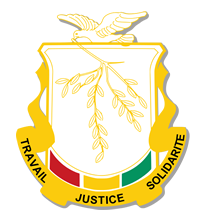Guinea: Government
Key Figures
- Chief of State:
- President Mamady Doumbouya
- Head of Government:
- Prime Minister Bernard Gomou
Overview
- Government Name:
- Republic of Guinea
- Constitution:
- Adopted: 1990; Outlines the separation of powers among the executive, legislative, and judicial branches and establishes a republican form of government (temporarily suspended).
- Government Type:
- Republic

Index of Economic Freedom
Grades each country on a scale of 0 to 100, based on ten freedoms, with 100 representing the greatest amount of economic autonomy from government intervention. Source: Heritage Foundation (2023)
Country Risk Rating
C
A very uncertain political and economic outlook and a business environment with many troublesome weaknesses can have a significant impact on corporate payment behavior. Corporate default probability is high. Source: Coface (2022)
Government Branches
| Main Powers | Election Process | Election Cycle 1 | |
|---|---|---|---|
| Executive | President and prime minister are in charge of executive tasks of the government. |
The president is elelcted by the absolute majority vote through a two round system and the prime minister is appointed by the president. |
5 years |
| Judicial | Supreme court is the highest court of the land. |
Appointed by presidential decree. |
Until dismissal by executive branch |
| Legislative | National assembly is in charge of creating legislature. |
38 seats elected by plurality vote in single-member constituencies. |
5 years |
Regional Trade Blocs
International Organization Participation [2]
Environmental Agreements [3]
Tax Information [2]
- Tax Authority:
- Information not available
- Tax Name:
- Information not available
Sources:
- ElectionGuide http://www.electionguide.org/
- EY, http://www.ey.com
- CIA World Factbook, https://www.cia.gov/the-world-factbook/
- U.S. Bilateral Relations Fact Sheets http://www.state.gov/r/pa/ei/bgn/


